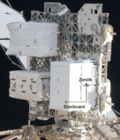
An EXpedite the PRocessing of Experiments to Space Station (ExPRESS) Logistics Carrier (ELC) is an unpressurized attached payload platform for the International Space Station (ISS) that provides mechanical mounting surfaces, electrical power, and command and data handling services for Orbital Replacement Units (ORUs) as well as science experiments on the ISS. The ELCs were developed primarily at the Goddard Space Flight Center in Greenbelt, Maryland, with support from JSC, KSC, and MSFC. ELC was formerly called "Express Pallet" and is the unpressurized counterpart to the pressurized ExPRESS Rack. An ELC provides scientists with a platform and infrastructure to deploy experiments in the vacuum of space without requiring a separate dedicated Earth-orbiting satellite.
Contents
- Description
- Electrical subsystem ExPRESS carrier avionics (ExPCA)
- ELC launch schedule
- Locations and components
- ELC-1
- ELC-2
- ELC-3
- ELC-4
- See also
- References
ELCs interface directly with the ISS integrated truss common attach system (CAS). [1] The P3 Truss has two such attach points called Unpressurised Cargo Carrier Attachment System (UCCAS) mechanisms, one facing zenith (space facing) called UCCAS-1, the other facing nadir (earth facing) called UCCAS-2. The S3 Truss has four similar locations called Payload Attachment System (PAS) mechanisms, two facing Zenith (PAS-1 and PAS-2), and two facing Nadir (PAS-3 and PAS-4).


























